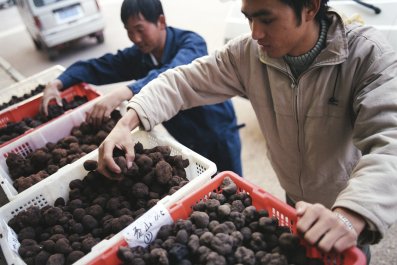America has a growing problem: more and more manure, produced at fewer sites and not effectively processed. It used to be that cattle, hogs and chickens were raised at many farms dispersed across the country, often with fields or large areas in which they could move around. The manure these animals produced was typically used to fertilize crops grown at the same or nearby farms, which were then used to feed the animals, creating a semi-sustainable feedback loop, says Steve Wing, a researcher at the University of North Carolina.
But those days are long gone, and the cycle is broken, Wing says. In North Carolina, for example, the number of hog farms has shrunk from more than 25,000 to a little over 2,000—while the hog population has more than tripled. And most of the manure isn't used to fertilize farms, he says, but instead sits in lagoons to fester, occasionally leaking out and contaminating nearby groundwater.
The trend is similar across the country. Most North Carolina hogs, and a majority of food animals in the U.S., are now at Concentrated Animal Feeding Operations, or CAFOs. These facilities, in which animals are housed in extremely tight quarters, produce massive amounts of manure.
According to the U.S. Department of Agriculture, animals at feeding operations—including CAFOs, houses, feedlots and other confinement facilities—produce 335 million tons of manure annually in the U.S. And that's in dry weight. If you include the liquid fraction and waste from smaller farms, food animals produce 2 billion tons of manure per year, according to a report just published by the Rachel Carson Council (RCC), a science-based, nonprofit environmental group.
American humans, on the other hand, produce 7 million tons of fecal material per year, as measured in dry weight. But unlike human waste, animal manure isn't processed at all, says Robert Musil, head of the RCC, and that's causing human health problems. Wing's research, for example, has shown that people who live near hog farms have higher rates of asthma and breathing problems, and that CAFOs are disproportionately located in areas populated by African-Americans and other people of color. Flooding of these facilities also releases unsafe levels of bacteria downstream.
One of the main problems, Wing says, is that the earthen lagoons in which all this manure is placed aren't properly protected from the elements; they're lined with only thin plastic or nothing at all. "All of them either are leaking or will leak, because that's a function of how they are engineered," Wing says. A representative study from the American Society of Agricultural Engineers shows, for example, that in Iowa, all 28 lagoons sampled leaked a little bit. But a small amount of leakage is legal and varies by state. Environmentalists and researchers like Wing and Musil say the amount of leakage allowed is unacceptably high, as are the emissions of odors and gases from these lagoons.
The pork industry, of course, disagrees. According to the National Pork Producers Council, farmers have been unfairly burdened by the U.S. Environmental Protection Agency. The group writes on its website that "while EPA has failed to demonstrate any adverse impacts on air quality standards associated with agricultural production, the agency continues to target the agricultural sector."




















